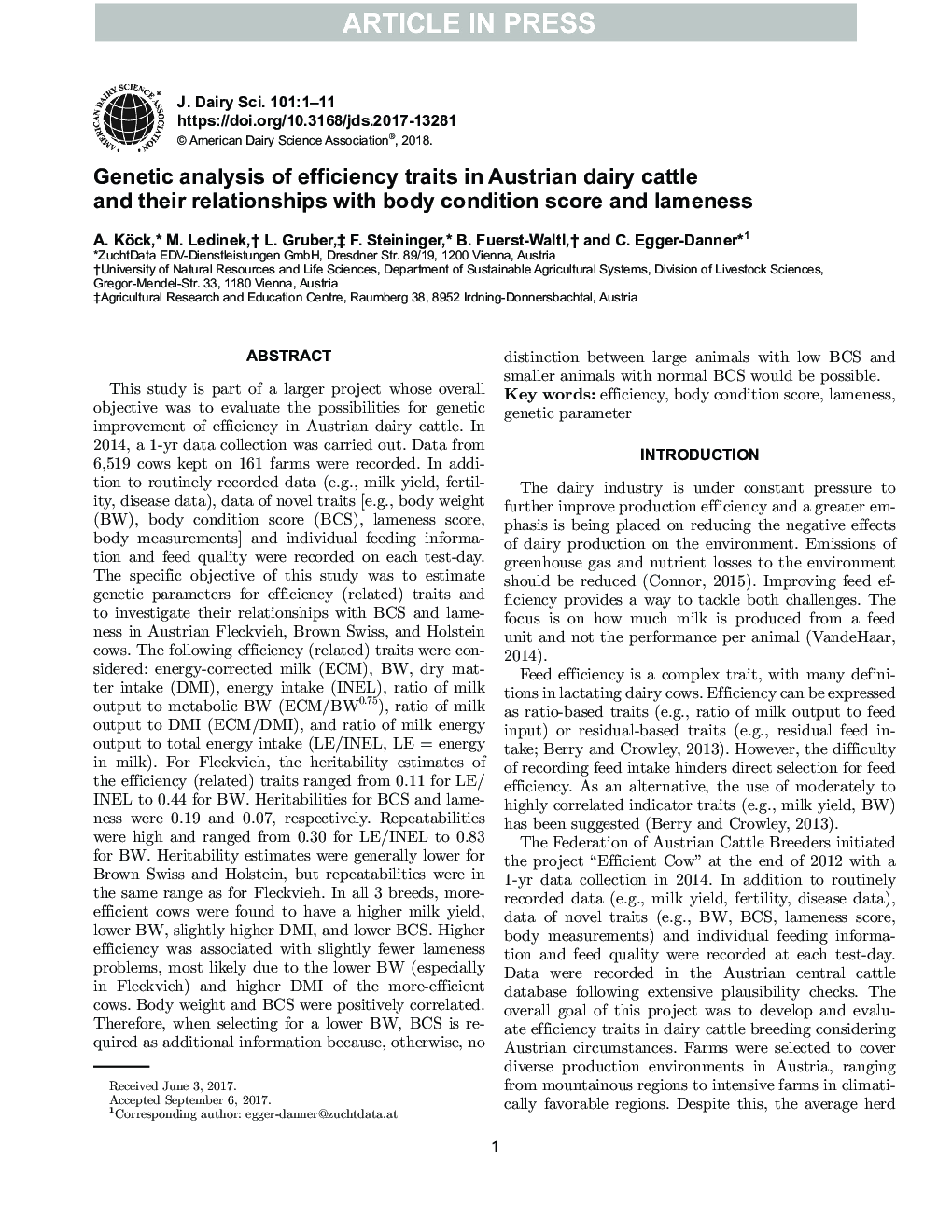| کد مقاله | کد نشریه | سال انتشار | مقاله انگلیسی | نسخه تمام متن |
|---|---|---|---|---|
| 8501681 | 1553844 | 2018 | 11 صفحه PDF | دانلود رایگان |
عنوان انگلیسی مقاله ISI
Genetic analysis of efficiency traits in Austrian dairy cattle and their relationships with body condition score and lameness
ترجمه فارسی عنوان
تجزیه و تحلیل ژنتیکی صفات کارایی در گاوهای لبنی اتریشی و روابط آنها با نمره وضعیت بدن و لنگش
دانلود مقاله + سفارش ترجمه
دانلود مقاله ISI انگلیسی
رایگان برای ایرانیان
کلمات کلیدی
بهره وری، نمره وضعیت بدن، لنگش پارامتر ژنتیکی،
موضوعات مرتبط
علوم زیستی و بیوفناوری
علوم کشاورزی و بیولوژیک
علوم دامی و جانورشناسی
چکیده انگلیسی
This study is part of a larger project whose overall objective was to evaluate the possibilities for genetic improvement of efficiency in Austrian dairy cattle. In 2014, a 1-yr data collection was carried out. Data from 6,519 cows kept on 161 farms were recorded. In addition to routinely recorded data (e.g., milk yield, fertility, disease data), data of novel traits [e.g., body weight (BW), body condition score (BCS), lameness score, body measurements] and individual feeding information and feed quality were recorded on each test-day. The specific objective of this study was to estimate genetic parameters for efficiency (related) traits and to investigate their relationships with BCS and lameness in Austrian Fleckvieh, Brown Swiss, and Holstein cows. The following efficiency (related) traits were considered: energy-corrected milk (ECM), BW, dry matter intake (DMI), energy intake (INEL), ratio of milk output to metabolic BW (ECM/BW0.75), ratio of milk output to DMI (ECM/DMI), and ratio of milk energy output to total energy intake (LE/INEL, LE = energy in milk). For Fleckvieh, the heritability estimates of the efficiency (related) traits ranged from 0.11 for LE/INEL to 0.44 for BW. Heritabilities for BCS and lameness were 0.19 and 0.07, respectively. Repeatabilities were high and ranged from 0.30 for LE/INEL to 0.83 for BW. Heritability estimates were generally lower for Brown Swiss and Holstein, but repeatabilities were in the same range as for Fleckvieh. In all 3 breeds, more-efficient cows were found to have a higher milk yield, lower BW, slightly higher DMI, and lower BCS. Higher efficiency was associated with slightly fewer lameness problems, most likely due to the lower BW (especially in Fleckvieh) and higher DMI of the more-efficient cows. Body weight and BCS were positively correlated. Therefore, when selecting for a lower BW, BCS is required as additional information because, otherwise, no distinction between large animals with low BCS and smaller animals with normal BCS would be possible.
ناشر
Database: Elsevier - ScienceDirect (ساینس دایرکت)
Journal: Journal of Dairy Science - Volume 101, Issue 1, January 2018, Pages 445-455
Journal: Journal of Dairy Science - Volume 101, Issue 1, January 2018, Pages 445-455
نویسندگان
A. Köck, M. Ledinek, L. Gruber, F. Steininger, B. Fuerst-Waltl, C. Egger-Danner,
